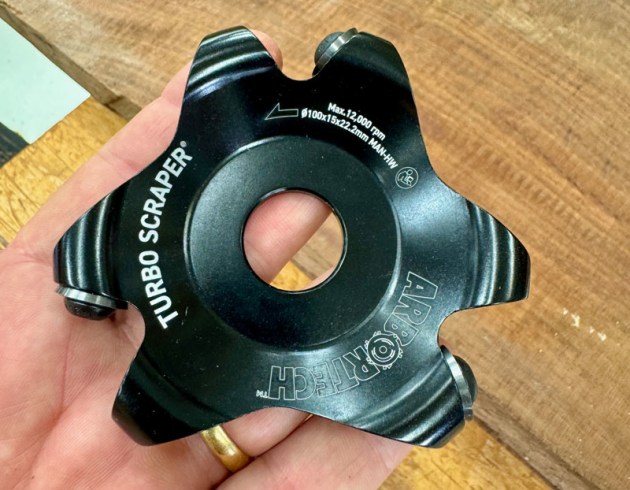TESTED: Arbortech TURBO Scraper
Words and photos: David Luckensmeyer
I’ve been using Arbortech products for more than thirty years and have experienced a number of design improvements first hand. The Turbo Scraper is the latest addition to their power carving range, and my favourite to date.
The Woodcarver was revolutionary at the time (and still is in its current iteration). In the early 90s, I used it to rough out organic forms – shaping ball and claw feet on a large dining room table. But the original tool could get away from you if you weren’t careful. More recently, I bought the TurboPlane and found it had the same ability to remove material quickly but with substantially more control.
So naturally I was curious about the new product. The Turbo Scraper affords more control than ever. The negative cutting angle makes it possible to work in any direction with no actual (or feared) gouging. It cuts more slowly by comparison, but this is a good thing: slower cutting is integral to increased levels of control. If you’re working on a totem pole or other such largescale carving projects, you’ll still want to use the Woodcarver and/or TurboPlane before moving on to the scraper. But for most of us, the new Turbo Scraper is all we are going to need.
The scraper has a depth of cut around 1mm which means a soft touch gives a relatively smooth, even result. Consequently, it textures surfaces beautifully. Using the face of the scraper offers the opportunity for subtle surface variations while on edge the scraper pretty much exactly approximates work with a carving gouge. I very quickly achieved a lightly scalloped surface that invites plenty of touching. The underneath side of chairs I make in future had better watch out!
But this is not just a texturing tool. Strokes along a curved pencil line take away material with surprising speed. There’s a paradox here that is best experienced personally. On the one hand, the shallow depth of cut combined with the negative cutting angle limit the amount of material removed. Even trying to make the scraper ‘gouge’ into a timber surface ends in failure. (Really, I tried.) But on the other hand, repetitive passes build up and pretty soon a fair amount of material has been removed.

There are a few standouts of this tool. For starters, it can be used in any direction with equanimity. It doesn’t seem to matter if I make passes with the grain, across the grain, or against the grain. It cuts (or scrapes) with ease. In addition, the advertising about being able to see through to the work while using the scraper is true. I’m used to taking passes (e.g. with other blades from Arbortech) and then checking the results afterwards. But this scraper, with its odd starlike shape, allows good visuality while shaping to a line. And finally, I’m a fan of tooling with replaceable insert knives. Except for instances of extreme abuse, such tooling should last indefinitely, however the price for a replacement set of knives is currently $60.

To be clear, this tool does not completely take the place of properly maintained and used hand tools. The feeling of contentment when a sharp blade passes through timber is sublime. After completing most of the carving, shaping or texturing with the Turbo Scraper, I still need to grab a hand scraper or fine sandpaper to refine the surface before applying a finish.
That said, the combination of control and power of this new scraper makes it the best tool Arbortech has produced to date. Yes I often like working quietly with hand tools. But I also like working efficiently to finish a project. And sometimes the volume of work requires a powered solution like this one. It is well worth the current $190 asking price and will definitely have a place in my shop.
Review tool supplied by Arbortech Tools, see https://www.arbortechtools.com



